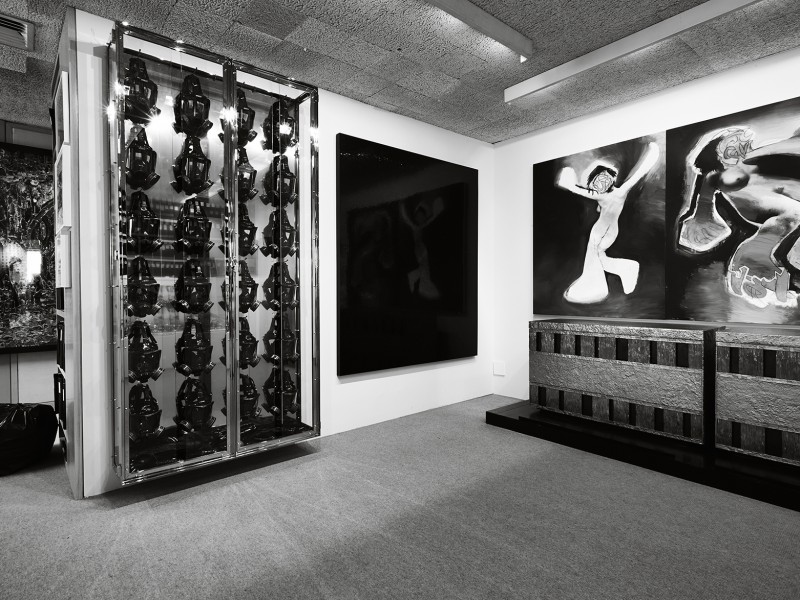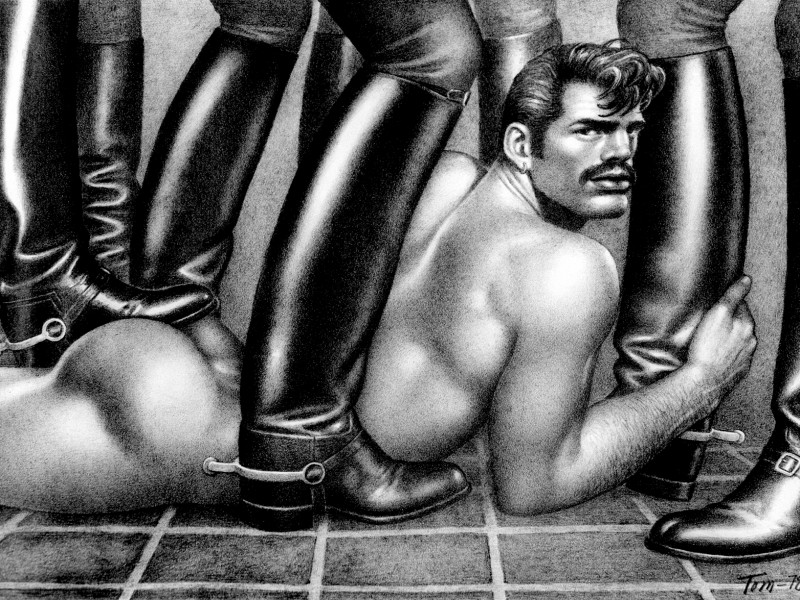Bob Richardson, in his unpublished biography, wrote: “There are two kinds of people on Earth, those who live in the past and those who live in the future. How have I been able to survive for 75 years? Guts—willpower—pride—I am very proud of myself—I am not ashamed of anything—I have no secrets—I am free.”
Richardson was first and foremost a survivor. His life was overshadowed by a battle with schizophrenia and homelessness, as well as generous experimentation with sex and drugs. But stripped of all this, Richardson was one of the most influential artists of photography’s most revolutionary period from the mid 1960s to the mid 1970s. A regular contributor to Harper’s Bazaar and Vogue, his images captured a dark and dreamy realism, that often featured models living out the emotions of everyday life, and embracing the attendant disillusions of the era with more than a passing nod to sex, drugs and rock ‘n’ roll.
Nancy Hall-Duncan—one of the first historians to apply her investigative lens to fashion photography—compares Richardson’s photographs to Avedon’s early work, saying they similarly derive their impact from a sense of spontaneity and contemporary meaning. “To view Richardson’s work is to share a tender moment, an instant of vulnerability and intimacy. His is touching and beautiful oeuvre, each shot the palpable record of personal communication.” His earliest work was renowned for conveying a deep sensitivity to contemporary culture. One photograph presents two women tousled and engulfed by windblown exuberance—a look achieved by the fact that they were both actually running on a treadmill—was criticised at the time for lesbian implications. Another shot showed models with dipped eyes smoking marijuana, but prior to publication their heads and the offending joints were cropped out.
Born in Long Island to Irish Catholic parents, Richardson attended Catholic schools before going on to study at Parsons School of Design, Pratt Institute and Cooper Union. Working professionally as a graphic designer and fashion illustrator—“like Warhol,” he once told Ingrid Sischy—he became interested in photography. In the early 1960s Richardson attended classes held by famed art director Alexey Brodovitch, and after absorbing all that the legendary Brodovitch had to teach, quickly became one of the sexiest and most directional photographers on the scene. Many editors found him difficult to work with, but he had the trust of some major art directors, such as Ruth Ansel and Bea Fiedler at Harper’s Bazaar. Deborah Turbeville—a young editor who worked with him at the magazine who later became a significant fashion photographer in her own right—recalled after Richardson’s death in The New York Times, how his influence changed her career. “I was a fashion editor and wasn’t interested in taking photos until I worked with Bob. He would dream up these incredible scenarios for sittings that were great for me to go off and get the perfect clothes for. I remember Avedon calling, asking me to work with him because, he said, ‘You and Bob are doing the most interesting stuff out there’.”
Despite his talent, Richardson had several clashes with editors and collaborators which left his reputation in tatters, ending his three year stint at Harper’s Bazaar. In 1967, during this volatile period, Richardson began to work prominently in Europe and produced some of his most iconic photographs. “American magazines are cowards,” he told PDN in 1997. “In Europe I’m considered a genius; in New York I’m nobody.”
What could be considered Richardson’s most famous shoot was undertaken with the sole assistance of his then wife Norma. The sixteen page spread, A la Conquête de l’Intimate Grecque, for Vogue Paris, was shot in Greece and could hardly be considered a fashion spread, but rather a cinematic study of a woman’s life lived passionately. The protagonist of Richardson’s story was Donna Mitchell, a woman that was described as ‘Disco Marilyn’ in the seventies. She is seen dancing with abandon in the Babulas Taverna, in Rhodes; she contemplates candles in a church; plays with a naked toddler (a young Terry Richardson, Bob’s son) in a bathtub; does her makeup; walks through the streets as if in mourning. On a rocky shore she lies supine, as a godlike nude swimmer emerges from the water. In one of the shots, Mitchell is crying on the beach. The overwhelming impression is of deep emotion and passion—a sense of reality, sex, joy, loneliness and broken trust.
Joan Juliet Buck, a former editor of Vogue Paris and an esteemed writer, recalled her impressions to The New Yorker on seeing the pictures when they were first published. “It was just before the Summer of Love,” she remembered. “Our mothers wore those sleeveless dresses that seemed to be made out of cement. And even the new clothes by Courrèges and Ungaro were very structured. Richardson’s pictures had the opposite feeling. They said, ‘This is what I can be: I can be sad, I can be involved, I can relate, I can be sexual’. In those pictures, there was light—a world where sex and style didn’t cancel each other out.”
Steven Meisel credits Richardson with inspiring him at a young age. Speaking to Ingrid Sischy in 1995, he recalled the feeling of stumbling across one of Richardson’s pictures. “I was in sixth or seventh grade and, around 1968, and the minute I looked at his pictures, although I wasn’t aware of what I was seeing, I knew there was something that stood out … Now I realise that, in addition to everything else, the photographs have an intoxicating feeling. The youth thing and the drug thing—it’s all there. The greasy black eyelids that the models used then gave you the feeling that the girls were so zonked out that they could barely keep their eyes open. There were guys with black eye makeup in his pictures too. The women he photographed were unusual beauties, and they often looked as if they were lost, desolate, or frightened. Once, when I was in ninth grade, I saw Donna Mitchell on the street. It was drizzling, her hair was frizzy, and she had on a black cape. She looked like a Bob Richardson picture waiting to happen.”
After meeting an 18-year-old Angelica Huston in 1969 on a shoot for Bazaar, the 41-year-old photographer and his young model began a four year romance and an important artistic collaboration. Richardson and Huston had a tempestuous relationship, but the affair also produced some of Richardson’s greatest portraits and fashion photographs. “I was not a model as such, but understudying in New York. I had come over from London, where I had done a few editorials with Dick Avedon. It was the time of great photographers—Avedon, Irving Penn, Hiro, Sarah Moon, David Bailey, Helmut Newton, Guy Bourdin, Chris von Wangenheim—Bob was up there at the top of the list,” recalled Huston in Richardson’s 2006 obituary in The New York Times.
Huston was in some of the most controversially theatrical pictures that Richardson ever took, one of which portrayed her with a smouldering Nazi lover. “It was the early seventies—just after Visconti’s Damned came out—when Bob had the idea of doing this tremendously decadent, very Roman look for Valentino. It was very scary to walk through the streets of Rome with a Nazi. People were very aware, and I kept waiting for them to throw bottles at us. I think Bob to a certain degree was a shock artist, and this reflected his inner turmoil. His pictures always had a subtext—they were about his state of mind, about him.”
After his relationship with Huston ended in 1973, Richardson’s spark and flair for theatricality was lost. He continued working for another six years until he resigned from photography completely. “I kept going for years, but I had lost interest—it vanished,” Richardson said in The New Yorker. “It was like waking up one morning and finding yourself all alone and wondering what you’re going to do. In the end, I just gave up. I’d been taking lousy photographs, and I didn’t want to work anymore. I think I wanted to find out if I wanted to live.” He left for California and disappeared from the scene, eventually ending up homeless and losing the majority of his work. It was during this period that the impact and significance of his work was lost on the younger generation.
Richardson may never have resurfaced if it hadn’t been for Martin Harrison. An English art historian, Harrison was researching the history of fashion photography in the 1960s. During an interview with Richard Avedon, Richardson’s name kept resurfacing and his work was praised. Harrison went in search of the elusive Richardson and his photographs only to discover that both had vanished. In 1989, Harrison tracked down Richardson’s son and ex-wife, Norma. They knew that Richardson was living in the SRO hotel, but Richardson wouldn’t respond to messages that Harrison left or reply to letters he wrote. Harrison went to California to try his luck in person.
“I knocked on Bob’s door, and he opened it and said ‘I don’t want to be rude, but, I don’t want to be in your book. I’m not interested in my old pictures.’ I wanted to burst out crying,” Harrison told The New Yorker. “But then he lit up a cigarette and he invited me into his room. There was a bed, a sink, a tiny wardrobe, and there were newspaper photographs all over the walls. He had tacked up a Kertész poster and a picture by Bruce Weber torn out of a magazine. After a while, I pulled out some photocopies of his work, and he’d say things like ‘God, I was awful’. But mixed in with the self deprecation was a definite sense of professional self esteem.” The trip resulted in a few of Richardson’s photographs being published in Appearances: Fashion Photography Since 1945 (1991). The book gave Richardson recognition of a kind he hadn’t had in years. Today Richardson’s work is indicative of a certain period, and of a time when the turbulent woman—reckless in her lassitude—became heroic. “She let herself be used by life, and looked it, and that was the essence of her beauty,” said Avedon of this unconventional pin-up in The New Yorker. “That moment was brief. When it ended, some of us adapted. Richardson refused.”
Related Features
-
86
-
-
-

